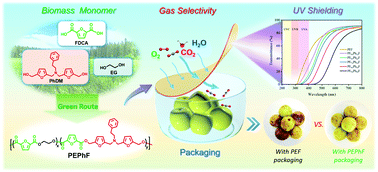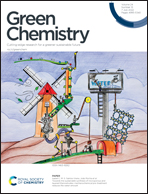Development of a series of biobased poly(ethylene 2,5-furandicarboxylate-co-(5,5′-((phenethylazanediyl)bis(methylene))bis(furan-5,2-diyl))dimethylene 2,5-furandicarboxylate) copolymers via a sustainable and mild route: promising “breathing” food packaging materials†
Abstract
In recent years, a large number of studies have been performed on the modification of poly(ethylene 2,5-furandicarboxylate) (PEF), focused on improving its brittleness and crystallization rate. Here, we present a series of biobased copolyesters synthesized from 2,5-furandicarboxylate (FDCA), ethylene glycol (EG) and (5,5′-((phenethylazanediyl)bis(methylene))bis(furan-5,2-diyl))dimethanol (PhDM) via green and mild routes. The introduction of PhDM into the PEF backbone not only alters its thermal properties and mechanical properties, but also endows it with UV shielding performance and regulatable gas barrier properties. DSC analysis showed that the copolyesters were amorphous. Compared with PEF, the copolyesters achieved better thermal stability and the initial thermal decomposition temperature was increased by 8–41 °C. The tensile testing demonstrated that the copolymers possessed significantly improved elongation at break (εb = 15%–35%) compared with PEF (εb = 5%). Obviously, the copolyesters with 30 mol%, 40 mol% and 50 mol% PhDM could shield ∼100% UV light and all copolyesters exhibited good transparency in the visible region. Inherently, the O2, CO2 and water permeability coefficient (P) values of the copolymers increased with increasing PhDM content, and the CO2/O2 selectivity (α) value first increased and then decreased. The copolymer film that contains 30% PhDM (mol/mol), and shows high CO2/O2 selectivity (α = 6.8) in comparison to PEF (α = 1.3) and polypropylene (PP) (α = 3.3), was selected to test its food preservation ability with fresh winter jujube. Winter jujube packed with PhDM can be preserved for one week without deterioration, compared with the winter jujube packed with PEF, which has obviously rotted. These results indicate that the copolymer is a promising packaging material for fresh fruit preservation.



 Please wait while we load your content...
Please wait while we load your content...